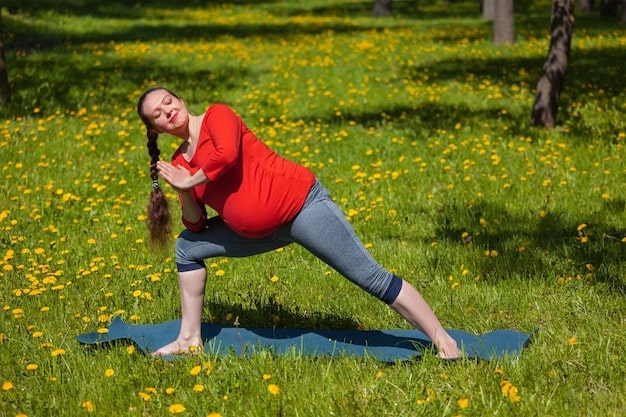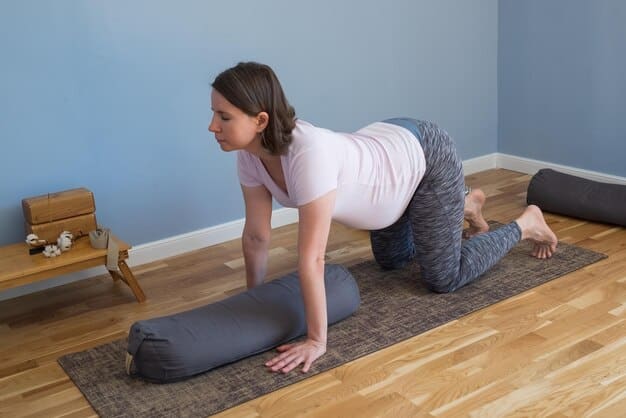Yoga for Pregnancy: Safe Poses for Each Trimester (2025)

Yoga for pregnancy offers numerous benefits, with safe and effective poses tailored for each trimester, and updated guidelines for 2025 ensure expecting mothers can practice safely and comfortably, promoting physical and mental well-being throughout their pregnancy.
Navigating pregnancy involves prioritizing your health and well-being, and yoga for pregnancy: safe and effective poses for each trimester, updated for 2025 guidelines provides a gentle yet powerful way to stay active, manage stress, and prepare for childbirth.
Understanding Yoga During Pregnancy
Yoga during pregnancy is more than just physical exercise; it’s a holistic approach that integrates physical postures, breathing techniques, and mental relaxation. This practice can be incredibly beneficial for expecting mothers, but it’s crucial to understand how to modify your yoga routine to suit each stage of pregnancy.
As your body changes, so should your yoga practice. Here are some key considerations to keep in mind when practicing yoga during pregnancy:
Benefits of Prenatal Yoga
- Reduces stress and anxiety: Yoga helps to calm the mind and reduce cortisol levels, promoting a sense of well-being.
- Improves sleep: Regular practice can alleviate common pregnancy discomforts, leading to better sleep quality.
- Enhances flexibility and strength: Gentle stretches and poses help maintain flexibility and build strength, preparing the body for labor and delivery.
- Eases back pain: Specific poses can alleviate pressure on the spine and lower back, reducing back pain.
Practicing yoga during pregnancy can significantly contribute to your overall health and well-being, provided it is done safely and with awareness of your body’s signals.
First Trimester Yoga: Gentle Beginnings

The first trimester brings many changes as your body adjusts to pregnancy. Yoga during this phase should be gentle, focusing on relaxation and relieving common symptoms like nausea and fatigue. It’s essential to listen to your body and avoid overexertion.
Here are some safe and effective yoga poses for the first trimester:
Safe Poses for the First Trimester
- Child’s Pose (Balasana): A comforting pose that gently stretches the hips, thighs, and ankles while calming the mind.
- Cat-Cow Pose (Marjaryasana to Bitilasana): Helps to improve posture, increase spinal flexibility, and relieve back pain.
- Mountain Pose (Tadasana): Enhances stability and grounding, promoting body awareness.
Remember to avoid poses that put pressure on the abdomen or involve deep twists. Always consult with your healthcare provider or a certified prenatal yoga instructor before starting any new exercise program.
In conclusion, the first trimester calls for a gentle and mindful approach to yoga, focusing on poses that promote relaxation, relieve discomfort, and enhance body awareness, while avoiding any movements that could potentially harm the developing fetus.
Second Trimester: Embracing the Changes
As you enter the second trimester, you may find that your energy levels increase. This is a great time to incorporate poses that build strength and stamina, while still being mindful of your growing belly. Modifications become more important during this phase.
Here are some recommended yoga poses for the second trimester:
Poses to Support Your Growing Belly
Embracing the second trimester means adapting poses to accommodate your growing belly and changing center of gravity.
- Warrior II (Virabhadrasana II): Builds strength in the legs and arms, while improving balance and stability. Use a wider stance for comfort.
- Triangle Pose (Trikonasana): Stretches the spine, hips, and hamstrings, while improving balance. Modify by placing your hand on a block or your shin.
- Supported Wide-Angle Seated Forward Bend (Upavistha Konasana): Gently stretches the inner thighs and hamstrings. Use a blanket under your hips for comfort.
Pay attention to your body’s alignment and avoid any poses that compress your abdomen. Staying aware and mindful will help you make the necessary adjustments to maintain safety and comfort.
In summary, the second trimester is a period of increased energy, allowing for a wider range of yoga poses to be practiced with appropriate modifications to accommodate the growing belly and maintain balance.
Third Trimester: Preparing for Labor

The third trimester is all about preparing your body and mind for labor and delivery. Yoga during this phase should focus on poses that promote relaxation, open the hips, and ease discomfort. Gentle movements and breathing techniques are key.
As you approach your due date, consider these yoga poses:
Poses for Labor Preparation
Preparing for labor involves incorporating poses that help open the hips, ease discomfort, and promote relaxation.
- Squat (Malasana): Opens the hips and strengthens the pelvic floor muscles, preparing you for labor.
- Supported Reclining Butterfly Pose (Supta Baddha Konasana): Gently opens the hips and inner thighs, while promoting relaxation. Use pillows or bolsters for support.
- Gentle Pelvic Tilts: Improves spinal flexibility and relieves back pain.
Always use props to support your body and avoid any poses that feel uncomfortable. This is a time to nurture yourself and prepare for the incredible journey of childbirth.
In conclusion, the third trimester focuses on gentle yoga practices that open the hips, promote relaxation, and prepare the body for labor, with an emphasis on using props for support and avoiding any poses that cause discomfort.
Breathing Techniques for Pregnancy Yoga
Breathing techniques, or pranayama, are an integral part of yoga and can be particularly beneficial during pregnancy. They help manage stress, improve oxygen flow, and prepare you for labor. Focus on diaphragmatic breathing, which promotes relaxation and lowers blood pressure.
Here are some essential breathing techniques for pregnancy yoga:
Effective Breathing Methods
Mastering effective breathing techniques can help you manage stress, improve oxygen flow, and prepare for labor.
- Diaphragmatic Breathing (Belly Breathing): Involves deep, slow breaths that expand the belly, promoting relaxation.
- Alternate Nostril Breathing (Nadi Shodhana): Balances the nervous system, reducing stress and anxiety.
- Cooling Breath (Sitali Pranayama): Helps to cool the body and calm the mind, particularly useful during hot flashes.
Practice these breathing techniques regularly to enhance your overall well-being and prepare yourself for the demands of labor.
In simple terms, learning and practicing breathing techniques is invaluable during pregnancy as it strengthens relaxation, improves oxygen levels, and readies you for labor, thereby boosting wellness and readiness.
Modifications and Safety Guidelines for 2025
Yoga during pregnancy should always be practiced with modifications to ensure safety for both the mother and the baby. The 2025 guidelines emphasize the importance of avoiding poses that compress the abdomen, overstretch the joints, or compromise balance.
Key safety guidelines include:
Essential Safety Tips
Following essential safety tips ensures yoga practice during pregnancy remains safe and beneficial.
- Avoid lying flat on your back after the first trimester, as it can compress the vena cava and restrict blood flow.
- Use props like blocks, bolsters, and blankets to support your body and prevent overstretching.
- Stay hydrated by drinking plenty of water before, during, and after your yoga practice.
- Listen to your body and stop if you feel any pain or discomfort.
Always consult with your healthcare provider or a certified prenatal yoga instructor to ensure your yoga practice is safe and appropriate for your individual needs. Adhering to these guidelines will protect your well-being and that of your baby throughout your pregnancy.
In conclusion, always prioritize safety when practicing yoga during pregnancy by modifying poses, using props, staying hydrated, and seeking guidance from healthcare professionals and certified instructors to ensure a beneficial and safe experience.
Creating a Prenatal Yoga Routine
Designing a prenatal yoga routine involves selecting poses that are safe and effective for each trimester, while considering your individual needs and preferences. Start with gentle warm-ups, followed by a series of poses that build strength and flexibility, and end with relaxation techniques.
Here’s a sample prenatal yoga routine:
Sample Prenatal Yoga Routine
A well-structured prenatal yoga routine involves a mix of warm-ups, strength-building poses, and relaxation techniques.
- Warm-up: Gentle neck rolls, shoulder stretches, and wrist rotations.
- Poses: Cat-Cow Pose, Warrior II, Triangle Pose (modified), Squat.
- Breathing: Diaphragmatic Breathing, Alternate Nostril Breathing.
- Relaxation: Supported Reclining Pose (Supta Baddha Konasana) with guided meditation.
Customize your routine based on your comfort level and the recommendations of your healthcare provider or yoga instructor. Consistency is key to experiencing the full benefits of prenatal yoga. A balanced routine will help keep both mind and body in prime condition throughout the pregnancy.
In essence, crafting a personalized prenatal yoga regimen, combining targeted exercises with mindful breathing and calm relaxation, significantly aids in maintaining both emotional and physical well-being during pregnancy.
| Key Point | Brief Description |
|---|---|
| 🧘♀️ Safe Poses | Tailored yoga poses for each trimester. |
| 呼吸 Breathing Techniques | Use diaphragmatic and alternate nostril breathing. |
| 🤰Modifications | Adapt poses with props and avoid overstretching. |
| 🩺 Consult Professionals | Consult healthcare provider/yoga instructor. |
Frequently Asked Questions (FAQ)
▼
Yes, yoga is generally safe during all trimesters of pregnancy, but modifications are necessary. Always consult with your healthcare provider and a certified prenatal yoga instructor to ensure safe practices.
▼
Avoid hot yoga, deep twists, inversions, and poses that put pressure on your abdomen. Listen to your body and avoid anything that feels uncomfortable or strenuous.
▼
You can practice prenatal yoga several times a week, depending on your comfort level and schedule. Even 15-30 minutes a day can provide significant benefits.
▼
Prenatal yoga reduces stress, improves sleep, enhances flexibility and strength, eases back pain, and prepares your body for labor and delivery. It also promotes a sense of well-being.
▼
While not always necessary, props like yoga blocks, bolsters, and blankets can enhance your comfort and support your body during poses. A yoga mat is also recommended for stability.
Conclusion
Incorporating yoga for pregnancy: safe and effective poses for each trimester, updated for 2025 guidelines into your prenatal care routine can significantly enhance your physical and mental well-being. By following these guidelines and consulting with healthcare professionals, you can enjoy a safe and fulfilling yoga practice throughout your pregnancy, preparing yourself for a healthy and joyful childbirth experience.





